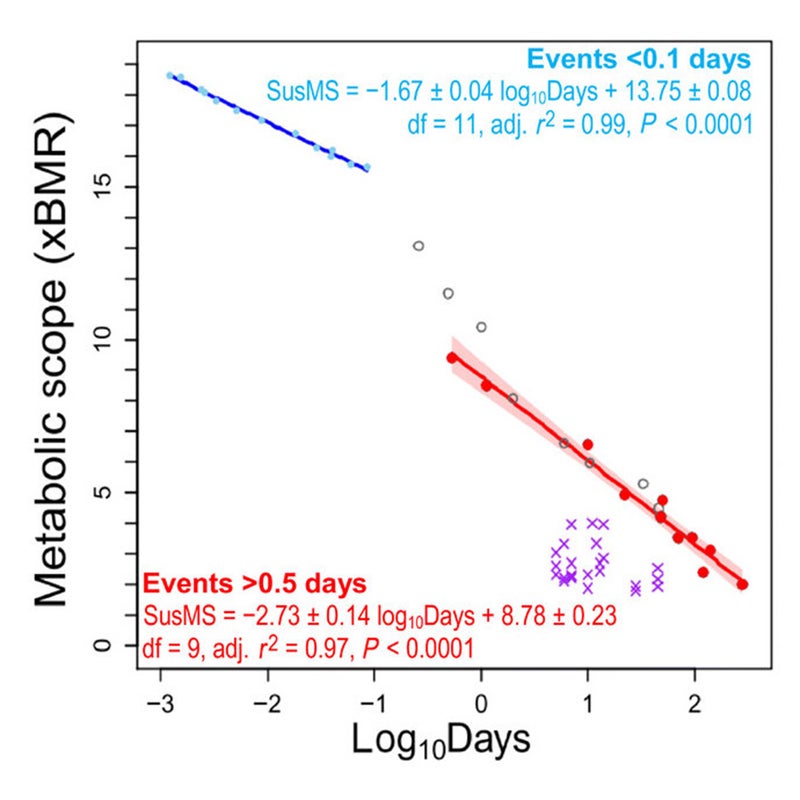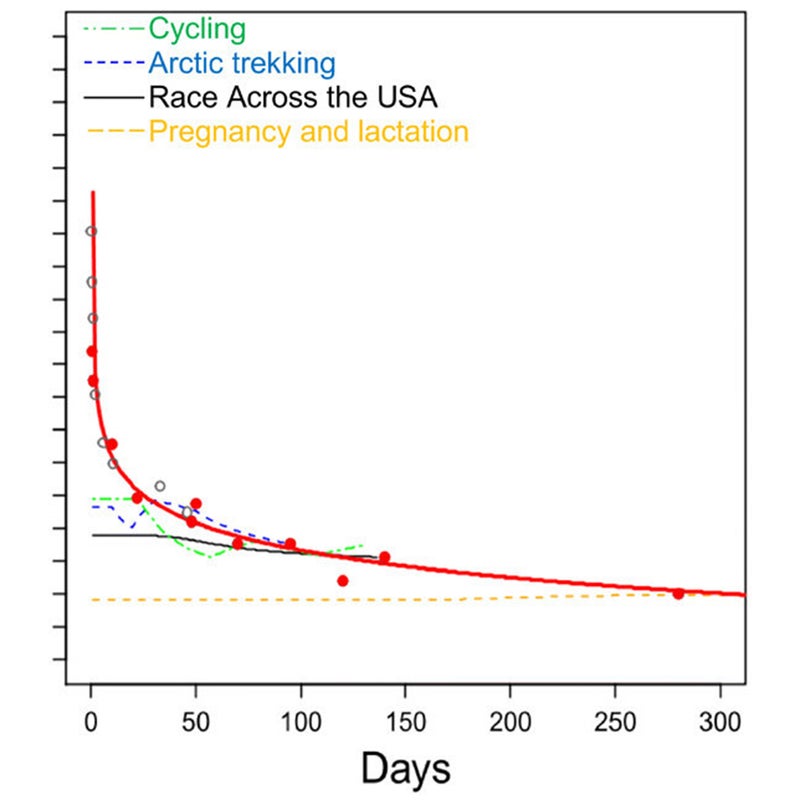Within a single half-hour period a few days ago, I got a text from an ex-SEAL trainer, a Facebook message from a neuroscientist in Virginia, and an email from my father-in-law, all giving me the same good news: “,” as the BBC headline put it. For the rest of the day, people kept pinging me—figuring, perhaps, that I’d want to write a final Sweat Science before winding the column down for good now that its raison d’être was gone.
Headlines, of course, don’t always capture the whole story. When I by a team led by Herman Pontzer of Duke University and John Speakman of the University of Aberdeen, I wasn’t surprised to discover that its actual findings were a tad more nuanced than the hype suggested. But it was interesting nonetheless, so I think it’s worth sharing a few thoughts on what the new study does (and doesn’t) tell us.
The data in the paper comes from the , a 140-day running event that crossed the continent from Huntington Beach, California, to Washington, D.C, in 2015. Some of the participants allowed themselves to be poked and prodded for the sake of science throughout the run. The most interesting insights in the paper comes from plotting that new data alongside endurance events of varying durations to look for patterns.
The fundamental question asked by the researchers is: what is the maximum rate at which you can burn calories over a sustained period of time? Rather than dealing directly with calories, they express the results in terms of “metabolic scope,” in multiples of your basal metabolic rate, which is how many calories you burn just lying around on the sofa. For someone who burns 1,500 calories per day just to stay alive, if they head out on a grueling trek that requires 4,500 calories per day, their metabolic scope would be 3.0 (4,500 divided by 1,500). That allows you to compare people of different sizes and shapes on a similar scale.
The Race Across USA runners started out burning about 6,200 calories a day during the first week of running, as measured by a technique that involved feeding the subjects water with specially labeled rare isotopes that allow its progress to be tracked through the body. That corresponded to an average metabolic scope of 3.76, but their calorie burn gradually declined over the duration of the race, resulting in an average metabolic scope over 140 days of 3.11.
This is not, however, the “ultimate limit of endurance.” It’s clear that you can burn more calories than that for shorter periods of time. An earlier study using the same technique, for example, found that Tour de France cyclists maintained a metabolic scope of 4.9 for 22 days. And a of Ranulph Fiennes and Mike Stroud as they hauled 500-pound sleds across the Antarctic found that they sustained a metabolic scope of 6.6 for ten days, and 3.5 for the full 95 days.
Instead, Pontzer and Speakman want to understand the relationship between how high of a calorie burn you can sustain and how long you can sustain it for. To do that, they comb through the literature for examples of impressive sustained energy burn, ranging from short running races like the 800 meters that last less than two minutes to grueling long-term ordeals like pregnancy. When you plot all of those points on one graph, they look like this:

Note that the horizontal axis is in logarithmic units. That means 0 corresponds to one day, 1 corresponds to 10 days, and 2 corresponds to 100 days. (In the other direction, -1 corresponds to a tenth of a day). In this view, you can see two distinct lines. The blue line corresponds to standard running events between 800 meters and the marathon. The red line, on the other hand, corresponds to longer activities like Antarctic trekking and multi-day races. (The purple crosses represent other assorted measurements of sustained energy expenditure, like wilderness firefighters, mountaineers, yacht racers, and so on.)
The shorter events represented by the blue line are what exercise physiologists spend most of their time discussing. The slope of that line is dictated by factors such as VO2max, which is a measure of how quickly you can deliver oxygen to your muscles. If that was all that mattered, you’d be able to maintain the same pace more or less indefinitely once you slowed down enough that your lungs and heart could keep up with your legs’ oxygen demands. But that’s clearly not what happens. The red curve has to be limited by something else.
If you replot the data from the red curve on a regular linear scale rather than a logarithmic one, this is what you see:

This is the what the headlines are talking about. As you extend to longer durations, the curve flattens out somewhere around a metabolic scope of 2.5. If you want to sustain a given workload indefinitely, this analysis suggests, you’ll need to make sure you’re not burning more than about two-and-a-half times more calories than your basal metabolic rate. That’s the ultimate limit of sustainable endurance.
When you look at that graph, of course, you can see that this limit is based on pretty sparse data. The second dot from the right, at 140 days, is the Race Across USA data. The dot to the left of that, at a metabolic scope of 2.4, is a measurement of eight Gambian farmers over a 120-day period during harvest—impressive, no doubt, but not necessarily what I would have assumed represents the ultimate limits of endurance. The rightmost dot, at 280 days, is a study of 19 women during pregnancy.
In other words, we can probably quibble about exactly where the limit is. Maybe it’s 2.6 rather than 2.5; maybe it’s 3.0. But leaving aside the exact number, it’s clear that the curve flattens out as you stretch to longer and longer durations. You’re not going to sustain a metabolic scope of 15—i.e. world-record marathon pace—for a year at a time. And it’s also clear that the limits when you’re talking about weeks or months are different from the oxygen-related limits that constrain short track and road races. So what drives those longer-term limits?
This is where the paper gets interesting. They suggest that we have an “alimentary energy supply limit”—that is, that we simply can’t digest calories quickly enough to sustain higher rates of long-term energy burn. That’s where the limit of 2.5 times your metabolic rate comes from: you can’t digest more than that. Of course, like the Antarctic trekkers, you can burn more than that—but you’ll simply lose weight, because some of those calories will come from the fat (and perhaps muscle) your body has stored, rather than the food you ate that day. Stroud and Fiennes, for example, lost 48 and 54 pounds respectively during their trek, running a daily caloric deficit that they clearly couldn’t have sustained for much longer.
To make this argument, Pontzer and Speakman don’t just stick to grueling endurance events. They also look at the opposite end of the spectrum, looking at data from eight “overfeeding” studies, in which subjects were forced to push the limits of gluttony. What they find is that here, too, intake seems to top out around 2.5 times basal metabolic rate. A typical basal metabolic rate is () about 1,600 calories per day, so that suggests most people can’t take down more than about 4,000 calories per day. And indeed, when they all the data together—overfeeding, pregnancy, feats of endurance—the amount of weight gained or lost does seem to suggest that calorie intake tops out around there.
So how do we reconcile all this with the famous stories of athletic gluttony? I’m not sure. It’s worth noting that, while the Race Across USA took 140 days, Pete Kostelnick covered the distance in just 42 days in 2016—while eating an estimated 9,000 to 14,000 calories per day. Was he just bad at estimating calories? Was he pooping out an enormous amount of undigested food? Is he a genetic freak? Or is it simply that a guy who crosses the continent in 42 days gives us a much better indicator of the actual limits of the human endurance than people who did the same thing in 140 days?
There are some other hints that truly elite athletes may push the curve to higher levels. As Pontzer and Speakman note in their paper, there are studies of Tour de France cyclists and cross-country skiers in which they sustain energy expenditures of 3.5 to 5 times their basal metabolic rate for as long as three weeks without losing any weight. That means they must have been successfully digesting that much food. That may reflect their nutritional strategies—perhaps sports drinks are so easily digestible that you can get more calories in—or simply mean that they’re outliers with unusually good eating abilities.
In the end, what’s interesting about this paper isn’t the specific number they come up with for the supposed limit of endurance. Instead, it’s the concept of an “alimentary” limit. When I spoke to Colin O’Brady before his Antarctic crossing last fall, one of his major tactical decisions was to bring about 8,000 calories of food per day, rather than the typical 5,000-calorie ration most previous explorers have used. At the time, I figured that was mainly a logistical gamble: could he carry the extra load? And would he be willing to chew and swallow all that food? But maybe there’s a more fundamental reason that most explorers have topped out at lower calorie counts—maybe, no matter how committed you are to eating, you simply can’t process that many calories. I’ll have to follow up with O’Brady to see how his eating plan shook out.
There’s a similar question lurking in a recent article I wrote about ketone drinks as a potential tool to ward off overtraining. One of the differences between the ketone group and the placebo group was that the ketone drinkers, without any prompting, chose to eat about 700 more calories per day. That extra energy may have been why the ketone group was seemingly able to handle a higher sustained training load, which raises the question of why those in the other group didn’t simply choose to eat more.
To me, that’s the deeper question underlying Pontzer and Speakman’s new research. Does the supposed limit of 2.5 times metabolic rate (plus or minus the normal variation in biological traits) represent a hard limit? Does it, as they speculate, have something to do with the size and shape of the digestive tract, or the genes involved in liver function? Or is the limit a softer one, more of a guideline dictated by our brain and our preferences—one that, say, Gambian farmers instinctively choose to obey during harvest season, but that Tour de France rides choose to ignore with no apparent ill effects? There’s only one way to find out: let’s hope the crazy people who do extreme endurance challenges start collecting more data on themselves.
My new book, , with a foreword by Malcolm Gladwell, is now available. For more, join me on and , and sign up for the Sweat Science .


